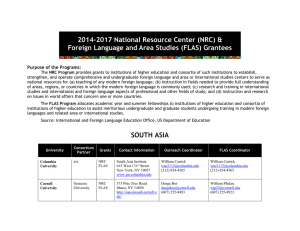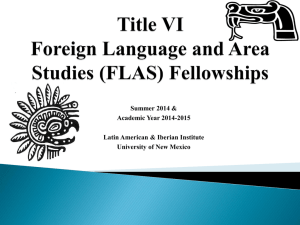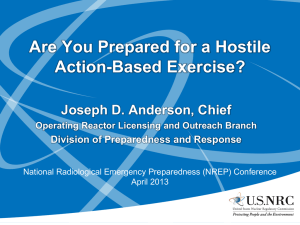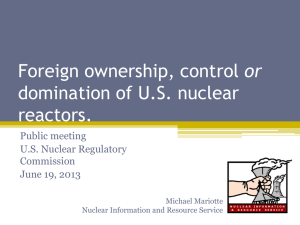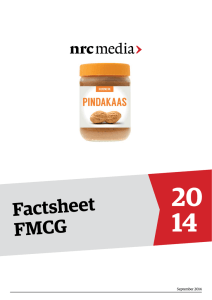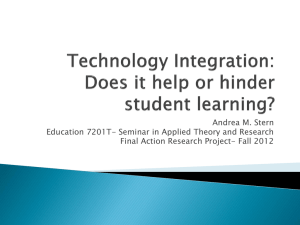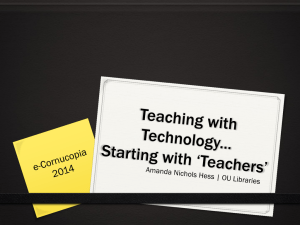2014 NRC/FLAS Grant Award Competition
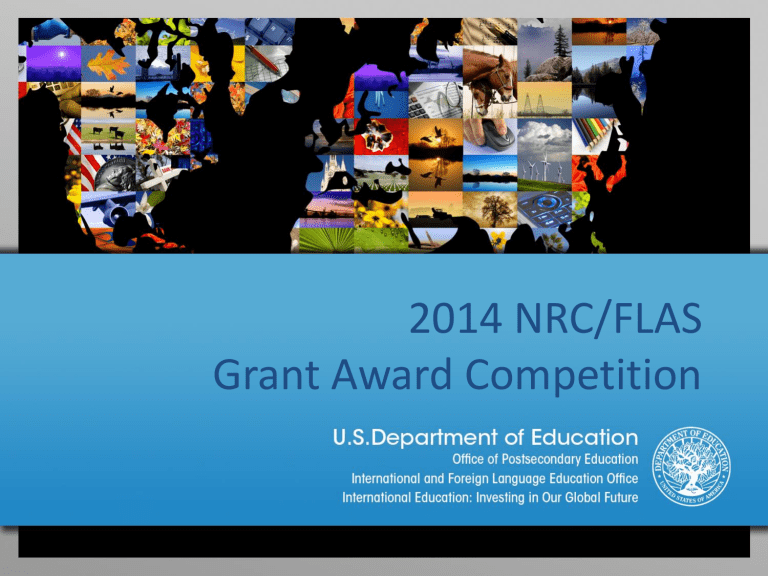
2014 NRC/FLAS
Grant Award Competition
2014 NRC/FLAS
G
RANT
A
WARD
C
OMPETITION
Welcome
The NRC/FLAS Team
Session Objectives
Presentations
Questions and Answers
Slide 2
L
EGISLATIVE
O
VERVIEW OF
T
ITLE
VI P
ROGRAMS
Background
National Defense Education Act of 1958
– Title VI Programs
Slide 3
O
VERVIEW OF
T
ITLE
VI P
ROGRAMS
American Overseas Resource Centers
Undergraduate International Studies and Foreign
Language
International and Research Studies
Centers for International Business Education
Business and International Education
National Resource Centers (NRC)
Foreign Language and Area Studies Fellowships
(FLAS)
Slide 4
NRC
AND
FLAS
The purpose of the NRC program
– To establish comprehensive area and international studies centers
– To provide instruction, research, and training in area and international studies that enable cultural understanding
The purpose of the FLAS program
– To enable advanced foreign language acquisition and fluency
– To develop a pool of international experts
Slide 5
T
YPES OF
P
RIORITIES
Absolute
Competitive Preference
Invitational
Slide 6
T
YPES OF
P
RIORITIES
Absolute priority
Consideration only for applications that meet the priority (34 CFR 75.105(c)(3))
Establishes eligibility
Slide 7
T
YPES OF
P
RIORITIES
Competitive Preference Priority
Under a competitive preference priority, we give competitive preference to an application by:
awarding additional points, depending on the extent to which the application meets the priority (34 CFR
75.105(c)(2)(i)) or
selecting an application that meets the priority over an application of comparable merit that does not meet the priority (34 CFR 75.105(c)(2)(ii))
Slide 8
T
YPES OF
P
RIORITIES
Invitational Priority
Addresses particular interests
Does not receive preference or priority points
Slide 9
NRC A
BSOLUTE
P
RIORITY
Applications that provide for teacher training activities on the language, languages, area studies, or thematic focus of the center.
Slide 10
T YPES OF C ENTERS AND A PPLICATIONS
A Center or Program may focus on (656.4 (a)):
A single country or a world area and offer instruction in the principal language or languages of that country or area and those disciplinary fields necessary to provide a full understanding of the country or area;
OR
International studies or the international aspects of contemporary issues or topics such as international agriculture systems, international finance, while providing instruction in modern foreign languages.
Slide 11
T YPES OF C ENTERS AND A PPLICATIONS
Centers provide training at the
Graduate, professional and undergraduate levels as a comprehensive center
OR
Undergraduate level only, as an undergraduate center
Slide 12
T YPES OF C ENTERS AND A PPLICATIONS
Comprehensive Center (656.7(d))
Advanced research and scholarship
Intensive language instruction
Important library collections related to the area of specialization
Graduate, professional and undergraduate student clientele
Curriculum development and community outreach
Slide 13
T YPES OF C ENTERS AND A PPLICATIONS
Undergraduate Center (656.7(f))
Education of students who matriculate into advanced language and area studies or professional school programs
Substantial international and foreign language content into baccalaureate degree program
Training available predominantly to undergraduate students
Research, curriculum development and community outreach
Slide 14
T
HE
NRC/FLAS
A
PPLICATION
R
EVIEW
Slide 15
NRC/FLAS A
PPLICATION
C
OMPONENTS
Application Forms
– Application for Federal Assistance (SF-424)
– Department of Education Supplemental Information for
SF424
– Budget form SF-524
– World Area Selection Sheet
– FLAS Approved Language List
– Narrative addressing GEPA Section 427
– GPRA and Project Performance Measure Forms (PMF)
– Application information to meet statutory requirements
• Diverse Perspectives and Wide Range of Views in Funded Activities
• Government Service in Areas of National Need and in Other
Employment Sectors
Slide 16
NRC/FLAS A
PPLICATION
C
OMPONENTS
Assurances and Certifications
– Assurances for Non-Construction Programs
(SF-424B)
– Lobbying Disclosure Form (SF LLL) (if applicable)
– Certification Regarding Lobbying (ED 80-0013)
Slide 17
NRC/FLAS A
PPLICATION
C
OMPONENTS
Abstract
Narrative
Budget
Faculty CVs (optional CV index)
Course lists
– 2012-2013: Courses offered and enrollment
– 2013-2014: Courses currently offered
– 2014-2015: Courses to be offered
Slide 18
S ELECTION C RITERIA FOR C OMPREHENSIVE
(656.21) AND U NDERGRADUATE NRC S (656.22)
(160 points)
Commitment to the subject area
Impact and evaluation
Quality of curriculum design
Quality of the center’s non-language instructional program
Quality of the center’s language instructional program
Strength of library
Quality of staff resources
Outreach activities
Program planning and budget
Competitive priorities
Slide 19
S ELECTION C RITERIA FOR F OREIGN L ANGUAGE
& A REA S TUDIES F ELLOWSHIPS (657.21)
(140 points)
Commitment to the subject area
Impact and evaluation
Quality of curriculum design
Quality of the non-language instructional program
Quality of the language instructional program
Strength of library
Quality of staff resources
Selection procedures for FLAS awardees
Competitive priorities
Slide 20
C OMMITMENT TO S UBJECT A REA
(10 points)
Intended to demonstrate the institution’s support for the center and, more specifically, for the proposed project.
Slide 21
C OMMITMENT TO S UBJECT A REA
Key elements that demonstrate commitment:
Institutional support for center’s operations, teaching staff, outreach activities, and students
Library resources
Linkages with overseas institutions
Key Question:
To what extent has the institution demonstrated its commitment to the center’s activities?
Slide 22
I MPACT AND E VALUATION
(30 points NRC, 25 points FLAS)
FY2014 GPRA Measures for NRCs
Percentage of NRC grants teaching intermediate or advanced courses in any of the priority languages as defined by the Secretary of Education.
– Use measure 1.3 of 4: Percentage of NRC grants teaching intermediate or advanced courses in priority languages.
Percentage of NRCs that increased the number of intermediate or advanced level language courses in the priority and/or LCTLs during the course of the grant period. (Long-term)
Slide 23
I MPACT AND E VALUATION
(30 points NRC, 25 points FLAS)
FY2014 GPRA Measures for NRCs
Percentage of priority languages targeted by NRCs as defined by the Secretary of Education taught at NRCs.
Percentage of NRCs that increased the number of certificate, minor, or major degree programs in the priority and/or LCTLs, area studies, or international studies during the course of the four-year grant period.
Efficiency measure: Cost per NRC that increased the number of intermediate or advanced level language
Slide 24
I MPACT AND E VALUATION
FY2014 GPRA Measures for FLAS
Percentage of Foreign Language and Area Studies
(FLAS) academic-year fellows who increased their foreign language reading, writing, and/or listening/ speaking scores by at least one ILR equivalent proficiency level.
Percentage of Foreign Language and Area Studies
(FLAS) graduated fellows who secured employment that utilizes their foreign language and area studies skills within 8 years after graduation based on FLAS tracking survey.
Slide 25
I MPACT AND E VALUATION
FY2014 GPRA Measures for FLAS
Percentage of Foreign Language and Area Studies
(FLAS) master’s and doctoral graduates who studied priority languages as defined by the
Secretary of Education.
Efficiency measure: cost per Foreign Language and Area Studies (FLAS) Fellowship Program academic year fellow who increased his/her reading, writing, and/or listening/speaking language score by at least one proficiency level
Slide 26
I MPACT AND E VALUATION
Application Criteria
Data about impact
Data measuring the center’s impact on the university, community, region and the nation
Data about student enrollment in advanced language and area or international studies (for undergraduate NRC applicants only)
Commitment to diversity
Center’s commitment to diversity and participant access.
Slide 27
I
MPACT AND
E
VALUATION
Evaluation Plan
Comprehensive evaluation plan with quantifiable, outcome-measure-oriented data.
Use of evaluations to improve its program.
Placement data
Placement data of undergraduate and graduate FLAS recipients (for FLAS applicants only)
Slide 28
I
MPACT AND
E
VALUATION
Generating and disseminating information that addresses nationals needs
Dissemination of information to the public.
(for NRC applicants)
Placement data of undergraduate and graduate FLAS recipients (for NRC applicants)
Slide 29
Q UALITY OF C URRICULUM D ESIGN (FLAS)
(20 points)
The Secretary reviews each application to determine the extent to which the applicant:
Incorporates undergraduate study into a baccalaureate degree program (major, minor, certificate);
provides programs and completion requirements for a variety of disciplines;
transitions to a quality graduate program;
provides academic and career advising services for students;
facilitates formal research and study abroad opportunities.
Slide 30
Q UALITY OF C URRICULUM D ESIGN (NRC)
(10 points)
Comprehensive Center
1.
is incorporated into a baccalaureate degree program;
2.
provides academic and career advising services for students;
3.
facilitates formal research and study abroad opportunities.
;
4.
provides training options for graduate students from a variety of disciplines and professional fields.
Undergraduate Center
1.
is incorporated into a baccalaureate degree program;
2.
provides academic and career advising services for students;
3.
facilitates formal research and study abroad opportunities.
Slide 31
Q UALITY OF N ON -L ANGUAGE
I NSTRUCTIONAL P ROGRAM
(20 points)
Includes content courses that are taught through the center (program), through nonlanguage departments, or through both.
Slide 32
Q UALITY OF N ON -L ANGUAGE
I NSTRUCTIONAL P ROGRAM
Courses in the professional schools (for Comprehensive NRCs), such as
Business, Law, Education, Journalism, Communications and Media,
Architecture, etc.
Examples:
– “The Political Economy of International Trade”
– “Modern Jewish Intellectual History”
– “Comparative Mystical Literature”
Tips
Use tables to show the professional schools and courses offered
Describe the availability of the courses to professional school students and indicate enrollments
Slide 33
Q UALITY OF N ON -L ANGUAGE
I NSTRUCTIONAL P ROGRAM
Include:
Interdisciplinary courses offered for undergraduate & graduate students (656.21)
Interdisciplinary courses offered for undergraduate students (656.22)
Interdisciplinary courses offered for students (657.22)
Courses in a variety of disciplines
Tips
Include courses with 25% - 100% content
Interdisciplinary courses involve two or more disciplines and/or departments.
Use narration and tables efficiently and effectively
Use cross references
Slide 34
Q UALITY OF N ON -L ANGUAGE
I NSTRUCTIONAL P ROGRAM
Specialized courses
Show depth of specialized course coverage in one or more disciplines of the center’s subject areas.
For example:
– Gateway courses leading to upper level courses
– Interdisciplinary seminar courses, directed studies, independent study, special topic seminars, research circles
Slide 35
Q UALITY OF N ON -L ANGUAGE
I NSTRUCTIONAL P ROGRAM
Faculty strength
Show sufficient number of non-language teaching faculty to enable the Center to carry out its purposes and instructional assistants provided with pedagogical training
Elaborate on faculty:
– Number
– Tenure track status
– % devoted to the subject area
– Department and discipline
Slide 36
Q UALITY OF N ON -L ANGUAGE
I NSTRUCTIONAL P ROGRAM
Pedagogical training for instructional assistants
Training and schedule
Resources
Oversight
Evaluation
Slide 37
Q UALITY OF L ANGUAGE I NSTRUCTIONAL P ROGRAM
(20 points)
Courses and Programs
Language faculty available to teach the languages/levels
Language courses taught through the Center and/or through language departments
Intensive language instruction (defined in 656.7(e))
Levels, when offered, enrollments (for each level), and students by type
Slide 38
Q UALITY OF L ANGUAGE I NSTRUCTIONAL P ROGRAM
Courses and Programs
Courses in disciplines other than language, literature,
and linguistics (LAC) offered in appropriate foreign languages, e.g.:
– “Spanish for Health Professionals”,
– “Chinese for Lawyers”,
– “Peoples and Cultures of the Himalayas”
Courses and programs offered by other providers
Courses offered on demand
Summer language institutes and enrollments
Slide 39
Q UALITY OF L ANGUAGE I NSTRUCTIONAL P ROGRAM
Pedagogical Training
Requirements for faculty, instructors, instructional assistants
Professional development
Faculty and instructor pedagogical distinctions
Tip
Cross reference other narrative sections and the appendices.
Slide 40
Q UALITY OF L ANGUAGE I NSTRUCTIONAL P ROGRAM
Performance-Based Instruction
Proficiency requirements for courses and levels
Student language competency outcomes
Assessments and when administered
Resources
Slide 41
S TRENGTH OF L IBRARY
(10 points)
The Secretary reviews each application to determine the strength of the institution’s library holdings (print and non-print, English and foreign language)
subject area and educational levels supported by the NRC;
institutional support;
collaborations, partnerships, cooperative arrangements.
Slide 42
Q UALITY OF S TAFF R ESOURCES
(15 points)
Staff qualifications
Staff development activities
Non-discriminatory employment practices
Slide 43
O UTREACH A CTIVITIES (NRC ONLY )
(20 points)
Domestic outreach to K-12, postsecondary institutions, business, media, and the general public that demonstrates:
significant and measurable regional and national impact
faculty and professional school involvement
Slide 44
P ROGRAM P LANNING AND B UDGET
(25 points)
The activities for which NRC funds are being requested
The relevance of the activities to the NRC program,
FY14 GPRA measures, and performance measures to the project objectives
Development plan or timeline that ultimately will result in a strengthened program
Resources (human and material) are used effectively and efficiently
Slide 45
P
ROGRAM
P
LANNING AND
B
UDGET
Reasonable costs in relation to objectives and scope
Anticipated impact of the proposed activities on the constituencies served
Sustainability plan after the grant ends
Tips
Avoid discussing the activities that were funded with past NRC grants.
Be clear about what you intend to achieve over the next four years
Cross-reference other sections of the narrative and the budget pages
Slide 46
FLAS A WARDEE S ELECTION P ROCEDURES
(15 points)
What to include:
Plan for advertising FLAS fellowships
Application process for students
Institution’s selection criteria
Selection committee
Process and timeline for notifying students (including post-award requirements)
Response to announced priorities (U.S. Department of Education)
Slide 47
A
PPLICATION
H
ELPFUL
H
INTS
Clearly and completely answer all parts of the question.
The narrative’s organization can vary, but consider dividing the application according to the criteria sections to make it easier for the reviewers.
Accurate, sufficient data are helpful to provide detail and to persuade.
Do not overly laden the narrative with acronyms.
Include indices where needed.
Be sure all pages of the proposal are included!
Have readable formatting. Line spacing in the appendices helps.
Include page numbers.
Include identifying header or footer on all pages.
Slide 48
